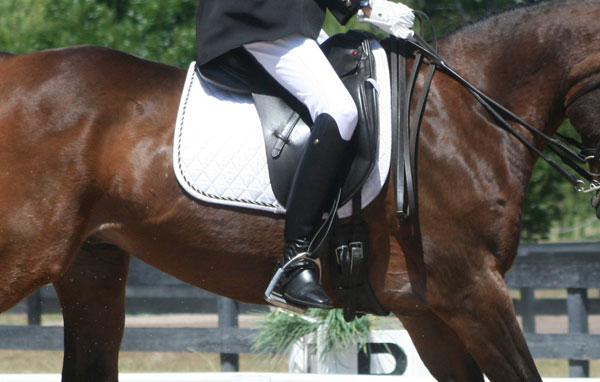I’m channeling George Morris here. He’s fond of saying that a lot of jumper riders need both shorter stirrups and shorter reins. I would say the same is true of dressage riders.

The longer-stirrups thing is something I see a lot with riders at Training and First Levels, not so much at the higher levels. That may be because upper-level riders have a more secure seat and the position of their foot in the stirrup isn’t as much of a concern. Maybe. I just see over and over that, when the toes are lower than the heels, it leads to all kinds of problems further north.
I don’t know if people ride with stirrups that are too long because they think: “Gee, dressage = long stirrups.” That is fundamentally wrong. Dressage = a longer leg. When the toes are lower than the heels, the back of the leg contracts. The leg becomes shorter, not longer. Thus, the ideal stirrup length is one that allows the heel to flex down lower than the toes and thus the entire leg to drop longer.
Notice the key word there: Flex. The ankle shouldn’t be rigid. A flexible ankle absorbs the energy of the horse’s stride instead of directing it into the rider’s back and allows the rider’s seat to be supple and steady. And a steady seat also allows for the hands to be steady as well. You can’t really solve a problem with the hands if the stirrups are too long to begin with and thus make the seat bounce. This is part of the reason why hinged stirrups seem to solve so many problems for a lot of riders. The flex action in the ankle gives more stability to the seat at the same time it relieves tension in the rider’s back.
Are riders using a too-long stirrup because they simply think the stirrup leather should be long for dressage? Or, maybe, because the stirrup leather has stretched subtly over time? Maybe they just haven’t given it much thought at all. Of course, a rider’s comfort-level with stirrup length is also determined by the conformation of the saddle flap. If the flap is too straight and coupled with a rigid knee roll, then it can often be difficult to raise the stirrups to a height where the heels can easily drop down, complicating the problem.
Anyway, if your heels can’t drop down lower than your toes, it might be worthwhile to experiment with stirrup length. A useful exercise is to try trotting in two-point (while holding mane midway up the horse’s neck if necessary). If you find it hard to do, that’s another indication that the stirrups should be a hole or two shorter.











